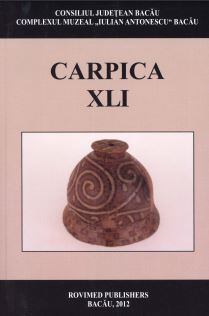
Ilie Săvescu, În luptă cu Zimbrul: povestiri istorice
Review of: Ilie Săvescu, În luptă cu Zimbrul: povestiri istorice, Roman, Editura Muşatină, 2010, 413 p.
More...We kindly inform you that, as long as the subject affiliation of our 300.000+ articles is in progress, you might get unsufficient or no results on your third level or second level search. In this case, please broaden your search criteria.

Review of: Ilie Săvescu, În luptă cu Zimbrul: povestiri istorice, Roman, Editura Muşatină, 2010, 413 p.
More...
This article focuses on the study of the archaeological investigations C. Buzdugan performed in 1963 in the Monteoru culture settlement at Gura Văii – Poiana Mirăuţă. We have applied a new analysis of the artefacts found there, and also proposed a dating for the Ic3 and Ic2 phases of the evolution of Monteoru culture.
More...
In the article, the author presents an ax miniature clay found in the settlement belonging to the culture Monteoru from Bogdăneşti-Todoscanu. Ax, worked in good quality paste, brown, just mimic battle axes made of stone.
More...
This article brings into question a stone scepter found in Măgura-Şipote, Bacău County, to the West of the city, on the eastern slope of Culmea Pietricica (com. Măgura, Bacău County). For this object the conditions of the discovery are not known but, on the basis of analogues can be attributed to the late Bronze Age (Noua culture).
More...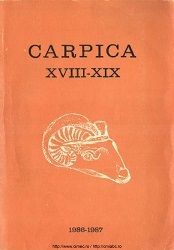
A I'occasion de recherches arheologique sur le territoire de la viile de Moineşti, pres de quartier Lucăceşti, a une altitude de 925 m, dans le point "Cetăţuia" a été découverte un nouvelle habitation géto-dacique avec un enceinte de quel-i ques cents metres carrés d'une forme rectangulaire...
More...
L' auteur présente synthéthetiquement toutes le decouverts arheologique avec la signification magique-religieuse appartenant à la civilisation géto-dacique, d'une maniére suivant...
More...
L' établissement fortifié dacique de Răcătău est situe sur la terrasse de gauche du Siret (l'antique Hierassus) et a été identifié par nous à la TAMASIDAVA de la Geographie de Ptolémée...
More...
Based on the archaeological data, the author discusses the possible existence of cult structures in the Late Bronze Age sites from the east of the Carpathians. These structures can be interpreted as having served as location for religious or ritual practices. In the archaeological literature it has been written about the votive role of the ,,ash mounds”, but the known data can not be generalized.
More...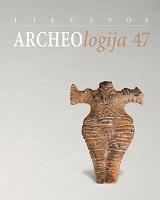
Marija Gimbutas (Gimbutienė) is a renowned archaeologist who specialised in European prehistory. This paper explores her life and work, including her personal biography, showing how her upbringing in Lithuania shaped her academic interests and orientations. This paper also reviews her professional achievements and contributions via the lenses of seven aspects of her academic life, namely her time in higher education, her work on Lithuanian folklore and symbolism, her explorations of Old Europe during the Neolithic, her Kurgan Hypothesis and engagement with Baltic studies, her excavations in southeast Europe, her work on the Goddess, and her symbolism work. It also examines academic and popular reactions to her writing and her influence on scholars and public discourse.
More...
Çatalhöyük East, a Neolithic site in Central Anatolia, has often been referred to as the place of the Mother Goddess. This is because of interpretations made by Mellaart, who discovered and excavated the site in the 1960s, when he discovered its striking symbolism. The female figurines among the finds are the most important reason for this fame. Therefore, various feminist groups have been attracted to this place because they perceived the site as a proof of the existence of a peaceful matriarchal community in the past. All of this is aligned with Gimbutas’ peaceful era theory, which has a Mother Goddess belief. This article will explain how archaeological finds at Çatalhöyük accompanied these theories in the time of Gimbutas and Mellaart and how new studies and new perspectives have altered these assumptions.
More...
The Indian subcontinent has been one of the regions of the world where the worship of goddesses has been amongst the most longstanding. The seminal work of Marija Gimbutas on the Neolithic and Copper Age settlements of southeastern Europe and particularly her explorations into the feminine forms of the period as possible expressions of Goddess worship have implications for the material culture of the Indian subcontinent in ways that have perhaps not been adequately addressed. Equally, insights into some of the surviving trajectories of rituals and iconographies of goddess worship might serve to throw more light on enigmatic aspects of archaeological finds including from the Neolithic, not just in the context of the subcontinent but elsewhere in antiquity. The paper also sets out to explore the place of the dancing form in ritual particularly with respect to goddess worship, which emerged as a more distinctive feature of Indian antiquity than in many other parts of the world.
More...
The aim of this article is to assess the value of Marija Alseikaitė-Gimbutienė’s (Gimbutas) 1946 dissertation published in Tübingen (Germany). It is also important to follow how much of an impact this work had on Lithuanian archaeology and what inspiration it may provide for scholars today. This paper concentrates on the parts of the book which deal with burial customs during the Roman Iron Age. Relevant problems of cultural divisions based on burial site types as per Gimbutienė are examined to see how much this classification may be accepted today. The second part of Gimbutienė’s dissertation, which focused on the meaning of burial customs, provides insights that are still important for scholarship today, and reveals the young scholar’s ability to reconstruct an old belief system and to discern the prospects for the further investigation of burial site material.
More...
In this article, I discuss the manner in which the model proposed by Marija Gimbutas regarding the IndoEuropean migration in Europe was perceived by Romanian specialists. The article is also an extension of my efforts to understand the relations between prehistoric Transylvania and the North-Pontic steppe. Approached from this historiographic perspective, the subject illustrates a situation symptomatic of Romanian archaeology: the lack, with few exceptions, of serious debates on this controversial subject, the frequent repetition of unverified opinions, statements supported by invalid arguments, etc.
More...
Cremation as a burial rite has been in use throughout prehistory. The graves as well as their fragmented content are the main informants reflecting the life and death of past communities in specific eras. So far, the studies of cremation graves in the eastern Baltic have mostly focused on reconstructing grave constructions and analysing artefacts. Far less attention has been paid to the skeletal material, especially to their value for reconstructing burial customs. In this paper we aim to outline how a detailed investigation of the skeletal material combined with statistical and spatial analysis can reveal burial customs and specific ritual practices, as well as the social status of the deceased. By applying these combined analyses, we were able to determine that both adults, incl. men and women, as well as children were buried at Viimsi I tarand cemetery in Estonia. Furthermore, we could establish specific burial practices centred around the skulls and different firing treatments of different body parts.
More...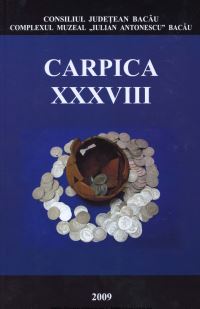
In this paper, the author presents some informations about a new settlement wich belong to the Middle Bronze Age, Costişa culture. The settlement was discovered in 2008, due to the surface researches. It is located about 3 km south-west of the Târgu Neamţ town, on the Osoi Hill (Neamţ country).
More...
Selon l’opinion des archéoloques il sera difficile et même impossible l’identification des groupes ethniqués et linguistiques antérieurs à l’âge du bronze sans une tradition historique, qui permetrait d’abaisser avec quelques siecles et non des millénaires, comme il est le cas avec les Thraces à l’âge du bronze. Par la synthèse des autochtons énéolithiques avec les bergers nord-pontiques a été constitué dans la période de transition à l’âge du bronze (environ 2600- 2000 av. J.-Chr.), la base ethnique indoeuropéenne préthrace, respectivement la base sur laquelle on a crée la synthèse culturelle et ethnique du bronze ancien et moyen (XXème -XIVème siècle av. J.-Chr.).
More...
Review of: Nicolae Ursulescu, Cucuteni. Ecouri în epocă ale monografiei lui Hubert Schmidt, Iaşi, Editura Universităţii „Al.I. Cuza”, 2009, 166 p.
More...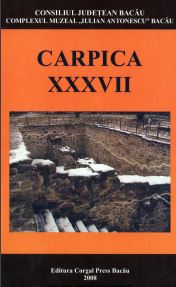
The archaeological researches carried out near several salt springs conducted to the discovery of specialised sites: seasonal sites (camps) that were laid out in order to exploit the salty waters. Those sites are documented in almost ali the prehistoric cultures in the peri-Carpathes zone of Romanian Moldavia, beginning with Starcevo-Criş. Fife such sites are to be related with the Prccucuteni communitics.
More...
Cet etude trate une decouverte de site cucuteniene de Fulgeriş, corn. de Pânceşti, dep. de Bacău. On analyse un figurine zoomorphe decouverte dans la section S X cherchee dans I'annee 2008, qui a etc emplacee pamletement avec la section S VIII/2007. Cette figurine zoomorphe se remarque par son decoration: des piqures sur le corps, qui sont comme decoration rarement.
More...
Dans cet ouvrage, on analyse une categorie a part d'objets, c'est-a-dire les haches en cuivre a tranchant oppose; l'auteur realise un repertoire (l'annexe 1) de ces haches decouvertes en Roumanie ou on retrouve des dates essentielles concemant ces pieces. Meme si la plus part d'elles ont ete des decouvertes fortuites, on peut apprecier le fait que les haches en cuivre a tranchant oppose sont caracteristiques a l'eneolithique, surgissant trequemment dans les espaces culturels Ariuşd-Cucutcni, Petreşti, Tiszapolgâr-Bodrogkeresztur et, plus rarement, dans les espaces Sălcuţa III-IV ou Coţofeni.
More...